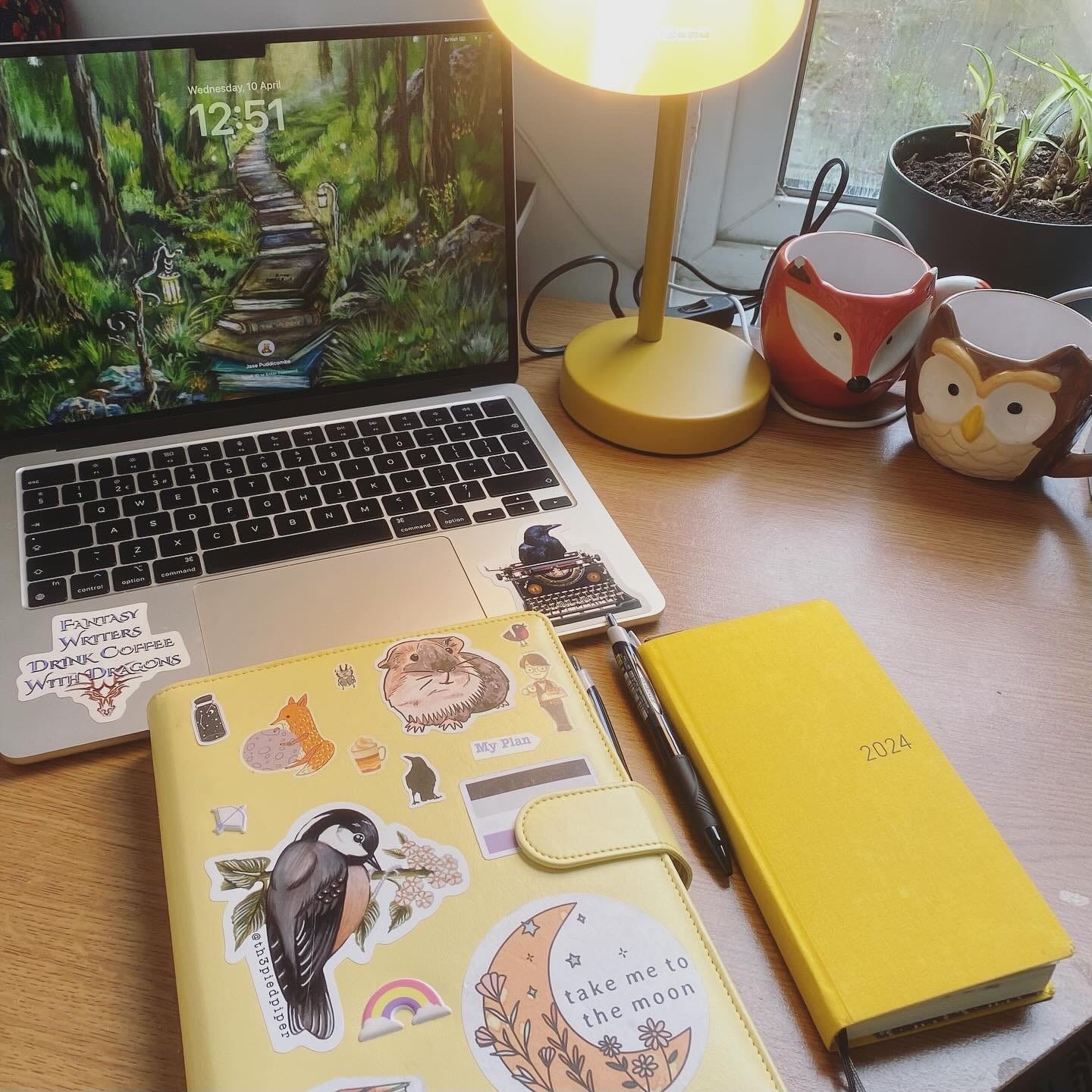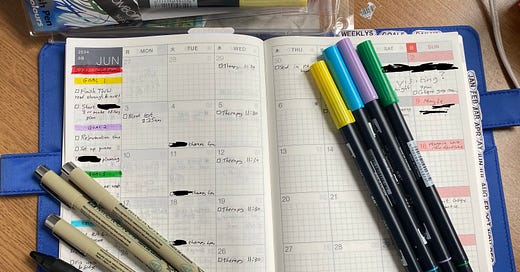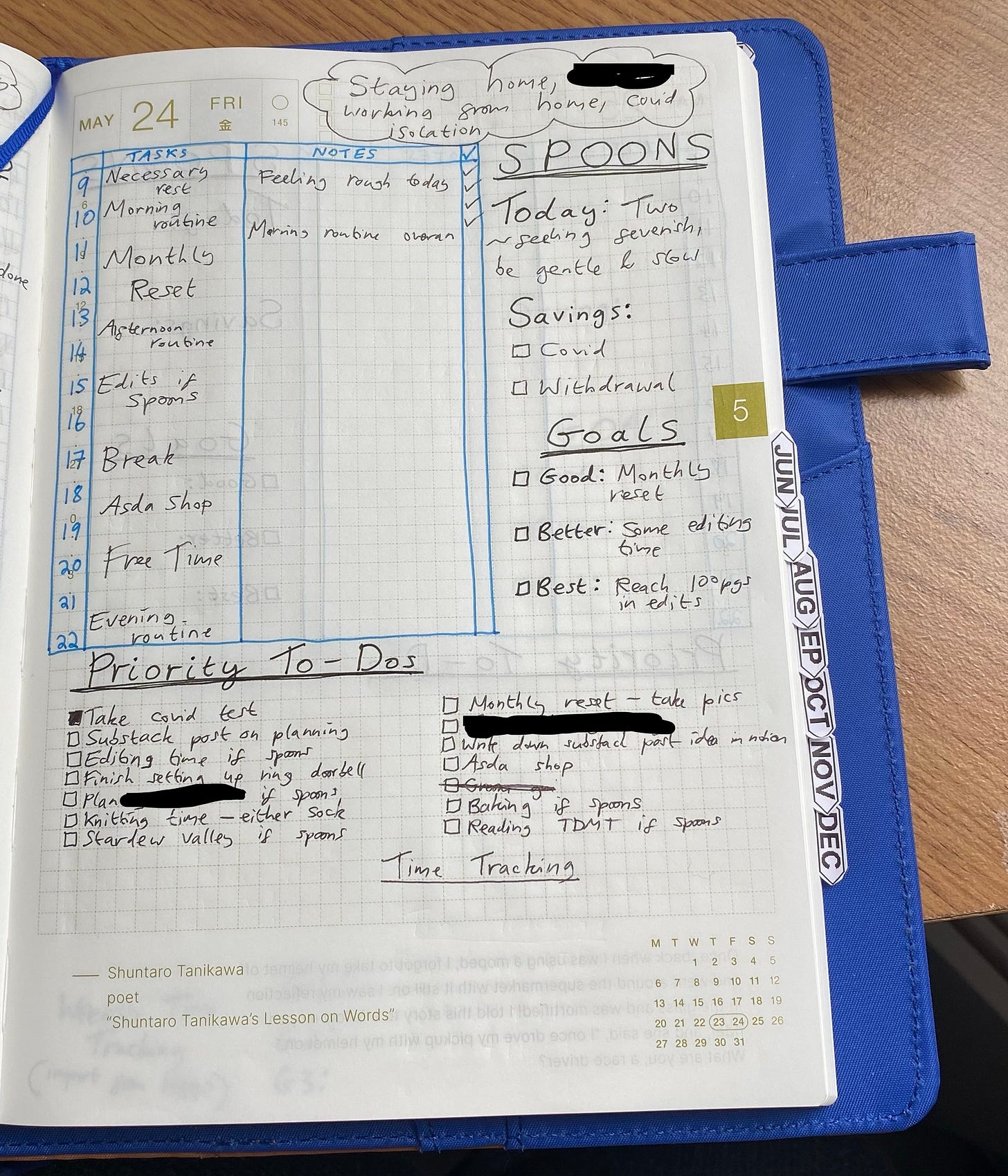Do you have a notebook graveyard of shame, too?
A peek inside my planning system - otherwise known as 'doing life homework'
I’m obsessed with planners.
Like a lot of writers I have a shelf full of notebooks, most half-used, gathering dust on the bookcase above the endless TBR collection. They are the ghosts of all the failed attempts at planning and organisation I have tried in the past. I kept searching for that one thing, the one magical system that would fix everything and suddenly make life easy.
Then I realised: life will never be easy, not for someone with my brain. I am neurodivergent and mentally ill in ways that make organisation and productivity very difficult - never mind my physical illness and disability that adds extra complications I really didn’t need. I was struggling because it’s hard.
One day, when complaining about how much time I have to put into a planning system just to be functional, my partner said: ‘it’s like doing life homework’. And a lightbulb switched on in my brain.
Life homework. Exactly! Everyone hates doing homework (except for the odd special interest subject: I used to love creative writing homework in school), but we all know homework is there for a reason, when it’s set correctly anyway. It’s (supposed to be) necessary for our education. And now, planning is necessary for me to have the kind of life I want - one where I meet my goals without running into overwhelm.
I have to plan in order to function, which sucks sometimes, but without it I only struggle more. It gave me permission to set aside three hours every Sunday just setting up the next week, blocking out my time and building in rest so that I wouldn’t overdo it. I used to think, three hours? No way I can spare that much time! But the truth is, if I don’t give myself space to plan, I never ever finish anything. I end up overwhelmed and paralysed.
Doing life homework doesn’t have to be boring, either. I let myself fully dive into the stickers and washi tape, the pretty notebooks and fun set-ups, because planning can be enjoyable too. While I still don’t believe there is a magical system that will fix everything, I have found one that works, and it has been working since I first implemented it last July. Through lots of trial and error, the last year has made me the happiest I’ve been in my adulthood. (Turning 30 helped; my 20s sucked).
So for this week’s post I thought I’d take you through how I plan my time. Partner and I are both sick with covid at the moment (thankfully mild, but we are isolating), which scuppered everything I had wanted to do this week, but that’s okay! Plans are there to be tweaked. Much like a first draft of a novel, I believe a plan is a rough draft of how I want life to go. Inevitably, it never works out exactly how I wanted it to, but that doesn’t mean it went wrong, not as long as I’m still moving in the right direction.
First Things First: Supplies
I mentioned that I like diving into the pretty side of planning. Over-consumption can absolutely be a problem here, and I’m on a tight budget, so I do have to exercise self-restraint. I’m also not at all artistic, at least not in the visual sense. I have little to no sense of colour. But I love covering my planners in stickers and washi tape and really, as long as it makes me happy every time I pick the notebook up, then it’s doing it’s job, isn’t it?
I have been through several different types of notebooks since I first truly started attempting to plan my time about five years ago. I started with bullet journalling, and stuck with it for quite some time - I have three leuchtturms’ that I love. But I also struggled a lot with consistency. Setting up every month was exhausting, and I found myself floundering without much structure. So now, I still use a bullet journal, but it’s purely for fun - for tracking my reading, video games, TV shows, knitting, and other fun rejuvenating activities.
I had tried dated books in the past and always struggled with the fear of missing a day - would I ever be okay with leaving a blank page? You can’t just rip a page out of a bound book, after all. So my next experiment was with a filofax. I bought a nice A5 cover from etsy and tucked my pages inside in order, and I liked the freedom of knowing if I had an off week, I could just take out those dates and move on.
The filofax worked well for about a year. I kept track of my appointments and meetings and social engagements, and I did some chronic illness management as well with pacing and spoons balancing, but I ran into a consistent problem: overbooking. I would cram in as much as I possibly could without building in time to rest, and, to no one’s surprise, end up burnt out. I also missed having notes pages to jot down to-do lists, or a consistent place to track habits.
Time blindness became an obvious problem as well. I really strugggle to estimate how long a task will take me, and I usually end up either giving myself hours for something that took 10 minutes to complete, or cramming twenty tasks into one day and only managing a quarter of them.
So: the filofax needed tweaking. I tried going fully digital - I use google calendar to co-ordinate with my partner, and I’m a big fan of notion too - but I like having time off screens. So last year I decided to dip my toe into the world of dated planners and bought myself a Hobonichi Weeks.
And I loved it.
The dates were all written out for me, meaning I didn’t have to set up every spread myself. I found with future planning I didn’t worry so much about missing a week - and scrawling ‘sick day’ in big letters across some pages doesn’t phase me anymore. That tells a story in itself. And tomoe river paper really is that lovely to use - I’m a full convert, so much so that I have since invested in a Hobonichi cousin and I think I will be a Hobonichi user for many years to come.

I started this year with a system that was finally working, but it was convoluted. My Weeks was my daily functional planner, but my long-term goals were still in my filofax, which I converted into an A5 Rings to use the HB90 system by Sarra Cannon. I kept notion to digitally store my boring day-to-day to-do list, with things like ‘call the plumber’ and ‘tidy the spare bedroom’ which didn’t really fit into my goals journal. And google calendar still held all my appointments and social plans.
I needed to streamline. So, after much mulling over whether it was really worth it, I decided to buy a 2024 January-start Hobonichi Cousin in the middle of May.
Why buy a planner when I can only use half of it, I hear you cry? Because I decided that having a good, functional system I enjoy for almost eight months was worth it.
The Hobonichi Cousin is not cheap. I think it is absolutely worth the investment, for the amount of joy and function I get from it, but I was nervous about spending that much on a planner when I hadn’t trialled it. But I knew that my system was working, and the Cousin would allow me to manage all the facets of my system in one book, rather than jumping between three or four places every day.
My Cousin arrived last week and I’m in LOVE. It’s saved me a huge amount of time already - today was my monthly reset and set-up for June, which used to take two-three hours, but I did it in less than half an hour today. Having everything streamlined in one book is working wonders for my brain.
I think it helped that I bought the Cousin with a very clear idea of how I would use it. Which brings me onto…
Setting Up My System
So I have all these pretty planners, but what do I actually do with them? I would love nothing more than to show you (I could rant about my notebooks for hours).
Let’s start with the Hobonichi Cousin, seeing as I just spent paragraphs raving about it:
The Cousin is a dated planner that comes with a yearly index, then monthly, weekly, and daily pages. There are a few note pages at the end but not enough to truly make use of (my one bug-bear with this planner) - I have them set up as GYST pages, for those get-your-shit-together days.
My yearly index, I use to mark down one good thing that happened each day. At the bottom, I also track three favourite songs, TV shows/books/games, and events from the month, so that it acts a memory-keeper and is a really nice at-a-glance positivity boost. It’s also right at the front of the planner, which brings me great joy every time I pick it up.
Monthly pages are purely functional for me - I get an overview of what my month looks like, where my appointments are, and how much rest I need to plan in before and after to make sure I don’t overdo it. I also have goal milestones down the side, with what I want to achieve that month.
My weeklys are my idealistic planning. Every Sunday I do a weekly reset where I spend time updating my running to-do list, with all the boring tasks mixed in with the more fun, goal-oriented ones. Then I take the list and plot it out in time-blocks each day of the week. I’ve got better at combatting my time blindness through time-tracking, which I’ll get into more when I talk about the daily sections, so I’m not too bad at guessing how long something will take me to complete now.
Having said that, my weekly spreads are very much a plan for a ‘perfect world’. I rarely ever complete all the tasks exactly when I said I would, but I find the clarity of having the week mapped out before it starts helps me stay focused and clear on what I’m aiming to achieve. I also do my habit tracking in my weeklys - it’s very eye-opening to see how many times I forget to take my meds, and the impact that can have on my producitivity!
And finally, the daily pages. I LOVE the daily pages. I used to think I couldn’t make use of an entire A5 page each day, but my mind has been entirely changed now I’ve found a way to use them that actively helps me make the best use of my time. I experimented with different layouts before settling on this one, and right now it’s working super well.
It’s very functional again - this book is about helping me focus, not being pretty. I have a pacing tracker table running through each usable hour of my day, where I can map out what I’d like to be doing, and then take notes on what actually happens (again: life very rarely goes to plan). I can make sure I’m pacing, building in enough breaks for my chronic fatigue, and see exactly where the hours go when I feel like I’m not getting anything done. It also lets me time track: at the bottom of each page, I note how long I spent on each task, which helps combat time blindness as I mentioned earlier.
I also note how many spoons I have each day and whether I have to save my energy for anything coming up. Doing that has helped me avoid overbooking myself, and acts as a reminder to factor in enough time to rest and recover before big events. (Note: a big event for me is a trip to the doctor for a blood test, or a video call with a group of friends - but they count!)
I really do love this book. It has everything I need for my functional day-to-day planning and I could not be happier about that.
I use notion every day as well - having a digital place to quickly jot down thoughts on my phone is invaluable - and my A5 Rings and bullet journal remain in rotation. But now I can dip in and out of them as and when I want to - all I need to get my day on track is in one book. And for me, that’s pretty great.
It’s all a bit convoluted though, isn’t it? Is it really worth it?
Short answer: yes and yes
Long answer: An in-depth planning system can seem really overwhelming when you’re new to it. Spending hours poring over several different notebooks is just another form of procrastination, isn’t it?
Yes, planning absolutely can be a form of avoidance. However, it can also be a tool to shape your day into what you actually want it to be, instead of getting pulled into distractions or not really knowing how to step towards your goals. I know I want to write a book, but if I don’t plan in writing time and research time and editing time, I would never ever get one finished.
Empty days are scary. I’m too sick to work, so my time stretches out in an endless sea with no blocks unless I put them there. I’ve tried not having much structure, and I don’t do well. My chronic fatigue requires strict pacing. My brain likes structure and rigidity, and doesn’t cope well with sudden change, which unfortunately happens a lot with chronic illness. I can’t predict when I’m suddenly going to be too sick to manage my normal tasks, but with planning, I have a better idea of how to cope when it happens.
Staying flexible and adjustable is key. I had to work through my perfectionist tendencies in order to find a system that really helps me, instead of bending my life to fit a system. The daily pages let me tweak my weekly plan as much as I need to. I no longer view it as a failure if I get to the end of a month and loads of the tasks I wanted to hit aren’t done yet. It just means I know what to schedule in next month.
Planning isn’t for everyone, and if you cringe at the thought of timetabling every second of your day, then my system won’t be for you. I do think it’s worth spending some time thinking about whether your current plan (or lack thereof) is working, or whether you want to find a way to get more clarity on how you spend your time. Hours used to disappear and I had no real idea where they went: now, for the most part, I can trace them back, and I’m actually achieving a lot more than I realised.
I’ll be achieving even more once I’m over this bout of covid!
I hope you’re having a lovely day in your corner of the world,
Jase









